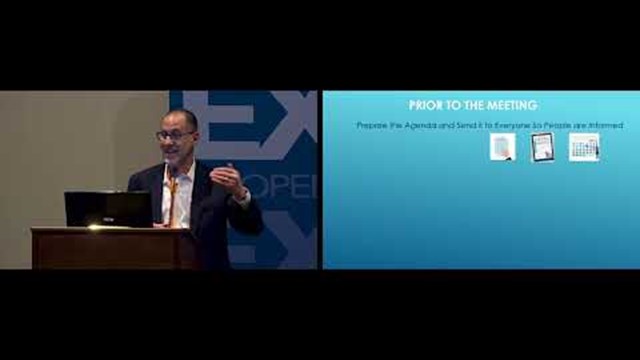Regardless of whether you live in a large co-op community with hundreds of units, a small self-managed co-op with a dozen, or a townhome condominium with just a few, board meetings can be both a chore and a headache. From shareholders or owners (or even fellow board members) getting up on their soapboxes, to inefficient time management, what should be a well-managed and fairly painless routine can turn into an hours-long nightmare.
But it doesn’t have to be that way.
Frank Aprilano is the president of the board of the Clinton Hill Apartment Owners Corporation, also known as the Clinton Hill Co-ops. There are 1,221 units in the cooperative, which is divided into two campuses located a few blocks from each other in Clinton Hill, Brooklyn. The community’s board consists of 16 members, and Aprilano has worked hard with the board to develop strategies to make their meetings run more smoothly. He says that on average, Clinton Hill Co-op meetings run around 90 minutes instead of three or four hours.
It Ain’t Alchemy
How do they pull that off in a community the size of a small town? Aprilano explains: “Rule number one was, we’re going to run more efficient meetings. Rule number two was: see rule number one!” he says.
Aprilano’s formula works, regardless of whether your monthly meetings are run by the board president or the building management; either way, the rules are the same.
“The way you manage a five-unit building is the same as if you manage a 200-unit building,” says Giovanni Puerta, an account executive with Trion Real Estate Management. He oversees Trion’s co-op and condo management division in New York City and Westchester. “You need to have order across the board,” he stresses.
What follows are some tips on how boards, managers, and committees can improve the quality and productivity of their meetings.
Stick to the Agenda
First and foremost, one of the primary factors that gets in the way of a smoothly run meeting is not having an agenda. Not only does each meeting need one, it should also be strictly adhered to, say the pros.
“That’s something that I prepare on a monthly basis. That’s a must for me,” explains Puerta. “Every association and board has different takes on how they want to run things. We like to have a streamlined system where they have their meeting and there’s an agenda.” The agenda is focused on financial reports and minutes, followed by new and old business, he says.
Steven Hirsch, executive managing director at FirstService Residential in Manhattan, agrees. One of the most common problems that bogs down board meetings is deviation from the structured agenda, he says.
“Regaining control of a meeting that has lost focus and order can be very challenging; especially to the managing agent who is sometimes put in a position of being an air traffic controller with responsibility of navigating the group back on task with a smooth landing. This requires finesse and discipline … Boards that get off on tangents can be redirected back to the agenda with an agreement to carve out non-agenda or ‘new business’ items for discussion at the end of the meeting, or at the next meeting,” he says.
Set Time Constraints
In addition to having an agenda, each item on that agenda should have a time limit – and that limit should be respected and enforced.
It’s very important for the manager to keep time on certain topics, says Puerta. For example, setting 15 minutes per agenda item. “And if there’s no agreement [after 15 minutes], you table it and move forward. A manager needs to mediate. I make it a point to wrap up old business, and bring back-up resources on new business.
“An efficient board meeting should be no longer than an hour to an hour and 15 minutes,” he adds.
For Hirsch, the magic number is a touch bigger. “An organized board meeting should not last longer than 90 minutes, unless there are specific topics or agenda items that would reasonably extend discussions, such as presentations,” he says. “Experience has shown that focus, attention and sometimes even mood start to wane after 90 minutes. Good decision making is not captured when this happens.”
So how can boards keep to a set time? One very effective way is to limit the topics of discussion at a given meeting.
“You shouldn’t be talking about something you’ve never spoken about before,” says Puerta. “What you want to handle at the meeting is decisions and approvals. That’s how you have efficient meetings.”
Don’t Get Personal
Although it can be difficult – especially for new board members – another tip that will help get and keep meetings on track is insisting that all remarks, asides, and proposals be kept professional and not emotional. This is easier said than done, given that co-ops and condos aren’t just business entities; they’re where real people live and raise their families. As such, some issues can take on a personal or emotional charge that sometimes make them difficult to discuss or decide in a detached, cool-headed manner.
A steady, voice-of-reason approach from the board president can help set the tone for a community’s meetings. For Aprilano, he says the other board members don’t take it personally when he has to end side conversation or even cut off a discussion. “Everybody understands where I’m coming from, and everyone understands the benefits of an efficient meeting,” he says.
According to Aprilano, it’s human nature for things to get off track. We all try not to step on each other’s toes … Everybody respects everybody else’s opinions.”
Puerta says a good way to keep things from getting personal is to have your building or association’s manager run the meeting, or at least present as it’s going on. “Their professional perspective can help you get over that hump,” he says. “Unless you have a professional opinion, you could just go on and on until you’re blue in the face.”
Time-Saving Technologies
Another way to keep board meetings efficient is to send out the minutes from the previous meeting and the agenda to board members electronically. That gives participants the chance to look over and familiarize themselves with old and new business items before the meeting and to formulate any concerns they want to have addressed before the meeting even begins.
Puerta says as the managing agent, he works with boards to draft their agendas and get them out to members about a week before a meeting is scheduled. That way, he says, questions can be answered ahead of time.
“I’ll work with management on the agenda for the meeting, and one of the biggest time savers that we’ve found [is sending] the minutes from the prior meeting,” he says.
He also sends out an “action list” each week that goes over everything the building or association has pending or under discussion. “Taking the time to look at the packet and being prepared is the best advice I could give to any board,” he says.
Hirsch says in addition to agendas and minutes, reports from property managers should also be sent to board members prior to meetings. Managers should be sure to include accounts payable, receivable and budget reports, any sales and title transfer reports or refinancing reports and capital projects reports, as needed.
Aprilano’s board is even more technologically advanced. They share a Google Doc among participants before the meeting, and only allot 10 minutes per meeting for discussion of previous minutes. “If it goes beyond that, the question is, did you read and edit on the Google document? Honestly we should spend 10 seconds on that. This board has really embraced technology,” he says, adding that much board discussion takes place on email.
Keep a Lid on Cross-Talk
It’s no great revelation that a meeting will be far more efficient if it doesn’t veer off into uncharted territory, with attendees carrying on their own conversations as the board president or manager is trying to address agenda items.
“Disruptive cross-talk and sidebar conversations” are among the most common issues that boards face that can throw a meeting into the weeds, Hirsch says. Putting the kibosh on chatter and off-topic tangents is a skill that a good board president or manager should cultivate, along with diplomacy and active listening. Guiding a chatty group back to the business at hand should be done firmly, but without making attendees feel they’re being silenced or that they’re concerns aren’t legitimate.
“If it doesn’t have to do with the topic at hand, bring it up in new business later in the agenda, or table it to committee,” Aprilano suggests.
Monthly Versus Annual – and a Word on Robert’s Rules of Order
Monthly meetings are not only shorter than annual meetings, but also tend to be less formal, experts say. Annual meetings may include board elections and often feature the building or association’s financial advisor presenting the annual report.
Regardless of whether it’s a monthly semi-formal gathering or a larger annual event, preparation for the meetings and the running of them remains the same, says Hirsch. Pre-meeting groundwork is still necessary, as is providing agendas and making sure the meeting stays on course.
Another tool that can be a godsend to boards – particularly those in large communities with lots of committees, projects, and concerns to manage – is Robert’s Rules of Order. Robert’s Rules is a widely-used and established set of parliamentary procedures that all kinds of groups use to direct their meetings, discussions and more. Some co-op and condo boards use them (or just the portions that are most directly useful to their particular group) to dictate how a meeting will proceed. The official Robert’s Rules website (www.robertsrules.com) offers full text of the rules, available for free to all.
Aprilano says when he became board president, Clinton Hill Co-ops adopted Robert’s Rules for all their meetings. “When we first came together, we introduced Robert’s Rules,” he says. “I’m not saying we follow it to the letter. If there’s talking over people, I put an immediate stop to that. If you have something to say, raise your hand, and I will recognize you.”
Organization Is Everything
For meetings to be their best, whether a manager or board president is taking the reins, what’s paramount is organization. That includes prior planning amongst members, agendas with time limits, pre-approval of minutes and more.
“Organization is the cornerstone to an efficient and productive meeting,” says Hirsch. “The foundation to conducting an efficient meeting is developed weeks before.”
Georgia Kral is a freelance writer and frequent contributor to The Cooperator.










Leave a Comment